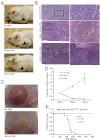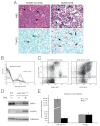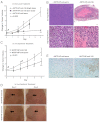Nanoparticle-based therapy in an in vivo microRNA-155 (miR-155)-dependent mouse model of lymphoma
- PMID: 22685206
- PMCID: PMC3387084
- DOI: 10.1073/pnas.1201516109
Nanoparticle-based therapy in an in vivo microRNA-155 (miR-155)-dependent mouse model of lymphoma
Abstract
MicroRNA-155 (miR-155) is an oncogenic microRNA that regulates several pathways involved in cell division and immunoregulation. It is overexpressed in numerous cancers, is often correlated with poor prognosis, and is thus a key target for future therapies. In this work we show that overexpression of miR-155 in lymphoid tissues results in disseminated lymphoma characterized by a clonal, transplantable pre-B-cell population of neoplastic lymphocytes. Withdrawal of miR-155 in mice with established disease results in rapid regression of lymphadenopathy, in part because of apoptosis of the malignant lymphocytes, demonstrating that these tumors are dependent on miR-155 expression. We show that systemic delivery of antisense peptide nucleic acids encapsulated in unique polymer nanoparticles inhibits miR-155 and slows the growth of these "addicted" pre-B-cell tumors in vivo, suggesting a promising therapeutic option for lymphoma/leukemia.
Conflict of interest statement
The authors declare no conflict of interest.
Figures







Similar articles
-
MicroRNA silencing for cancer therapy targeted to the tumour microenvironment.Nature. 2015 Feb 5;518(7537):107-10. doi: 10.1038/nature13905. Epub 2014 Nov 17. Nature. 2015. PMID: 25409146 Free PMC article.
-
MiR-467a is upregulated in radiation-induced mouse thymic lymphomas and regulates apoptosis by targeting Fas and Bax.Int J Biol Sci. 2015 Jan 1;11(1):109-21. doi: 10.7150/ijbs.10276. eCollection 2015. Int J Biol Sci. 2015. PMID: 25552935 Free PMC article.
-
Therapeutic Potential of Chemically Modified, Synthetic, Triplex Peptide Nucleic Acid-Based Oncomir Inhibitors for Cancer Therapy.Cancer Res. 2021 Nov 15;81(22):5613-5624. doi: 10.1158/0008-5472.CAN-21-0736. Epub 2021 Sep 21. Cancer Res. 2021. PMID: 34548334 Free PMC article.
-
Down regulation of miR200c promotes radiation-induced thymic lymphoma by targeting BMI1.J Cell Biochem. 2014 Jun;115(6):1033-42. doi: 10.1002/jcb.24754. J Cell Biochem. 2014. PMID: 24375660
-
MicroRNA-Based Therapy of GATA2-Deficient Vascular Disease.Circulation. 2016 Dec 13;134(24):1973-1990. doi: 10.1161/CIRCULATIONAHA.116.022478. Epub 2016 Oct 25. Circulation. 2016. PMID: 27780851
Cited by
-
Increased miR-155-5p and reduced miR-148a-3p contribute to the suppression of osteosarcoma cell death.Oncogene. 2016 Oct 6;35(40):5282-5294. doi: 10.1038/onc.2016.68. Epub 2016 Apr 4. Oncogene. 2016. PMID: 27041566
-
The emerging role of miRNAs in inflammatory bowel disease: a review.Therap Adv Gastroenterol. 2015 Jan;8(1):4-22. doi: 10.1177/1756283X14547360. Therap Adv Gastroenterol. 2015. PMID: 25553076 Free PMC article. Review.
-
miRNA therapeutics in precision oncology: a natural premium to nurture.Explor Target Antitumor Ther. 2022;3(4):511-532. doi: 10.37349/etat.2022.00098. Epub 2022 Aug 31. Explor Target Antitumor Ther. 2022. PMID: 36071981 Free PMC article. Review.
-
Gene targeted and immune therapies for nodal and gastrointestinal follicular lymphomas.World J Gastroenterol. 2023 Dec 28;29(48):6179-6197. doi: 10.3748/wjg.v29.i48.6179. World J Gastroenterol. 2023. PMID: 38186866 Free PMC article. Review.
-
DNA-Methylation-Caused Downregulation of miR-30 Contributes to the High Expression of XPO1 and the Aggressive Growth of Tumors in Pancreatic Ductal Adenocarcinoma.Cancers (Basel). 2019 Aug 2;11(8):1101. doi: 10.3390/cancers11081101. Cancers (Basel). 2019. PMID: 31382411 Free PMC article.
References
-
- Bartel DP. MicroRNAs: Genomics, biogenesis, mechanism, and function. Cell. 2004;116:281–297. - PubMed
-
- Babar IA, Slack FJ, Weidhaas JB. miRNA modulation of the cellular stress response. Future Oncol. 2008;4:289–298. - PubMed
-
- Alvarez-Garcia I, Miska EA. MicroRNA functions in animal development and human disease. Development. 2005;132:4653–4662. - PubMed
-
- Bushati N, Cohen SM. microRNA functions. Annu Rev Cell Dev Biol. 2007;23:175–205. - PubMed
Publication types
MeSH terms
Substances
Grants and funding
LinkOut - more resources
Full Text Sources
Other Literature Sources
Medical
Molecular Biology Databases

